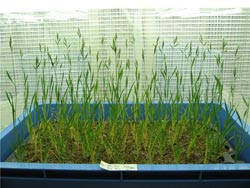RIKEN BioResource Center to provide seeds of model cereal plant

The model cereal plant Brachypodium distachyon<br>
Brachypodium distachyon belongs to the Poaceae family of monocot plants, which comprises temperate grasses and cereals and constitutes one of the most economically important plant families in the modern world. It is the first of the grass subfamily Pooideae to have a sequenced genome and it is widely used as a model plant for structural and functional genomic studies of grasses and cereals.
The seeds made available at BRC are of the Bd21 line, the standard line used in the sequencing project. In addition to the seeds, BRC will provide the scientific community with the technology needed for the cultivation and genetic alteration of Bd21.
“The BRC Brachypodium distachyon seed bank is the first of the kind in Asia. Our Bd21 seeds will be of particular interest to Asian scientists who can use it to generate transgenic plants and study monocot genes of agronomic interest.” Explains Dr. Kobayashi, Head of the Experimental Plant Division.
The Bd21 Brachypodium distachyon line is an important addition to BRC’s wide variety of bioresources, which already include human specimens, mice, the model plant Arabidopsis thaliana, cell lines, genes and microorganisms.
Since its establishment in 2001, the RIKEN BioResource Center has acted as a core bioresource facility for researchers through the collection, preservation and distribution of bioresources. Through these activities, the BRC supports studies in a broad range of fields, from basic research to the treatment of disease, health promotion, food production and environmental conservation.
http://www.riken.jp/en/pr/press/2013/20130405_2/
Media Contact
More Information:
http://www.riken.jpAll latest news from the category: Life Sciences and Chemistry
Articles and reports from the Life Sciences and chemistry area deal with applied and basic research into modern biology, chemistry and human medicine.
Valuable information can be found on a range of life sciences fields including bacteriology, biochemistry, bionics, bioinformatics, biophysics, biotechnology, genetics, geobotany, human biology, marine biology, microbiology, molecular biology, cellular biology, zoology, bioinorganic chemistry, microchemistry and environmental chemistry.
Newest articles

High-energy-density aqueous battery based on halogen multi-electron transfer
Traditional non-aqueous lithium-ion batteries have a high energy density, but their safety is compromised due to the flammable organic electrolytes they utilize. Aqueous batteries use water as the solvent for…

First-ever combined heart pump and pig kidney transplant
…gives new hope to patient with terminal illness. Surgeons at NYU Langone Health performed the first-ever combined mechanical heart pump and gene-edited pig kidney transplant surgery in a 54-year-old woman…

Biophysics: Testing how well biomarkers work
LMU researchers have developed a method to determine how reliably target proteins can be labeled using super-resolution fluorescence microscopy. Modern microscopy techniques make it possible to examine the inner workings…





















